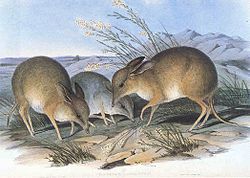Chaeropus
| Pig-footed Bandicoot | |
|---|---|

| |
Extinct (1950s)
| |
| Scientific classification | |
| Kingdom: | |
| Phylum: | |
| Class: | |
| Infraclass: | |
| Order: | |
| Family: | Chaeropodidae Gill, 1872
|
| Genus: | Chaeropus Ogilby, 1838
|
| Species: | C. ecaudatus
|
| Binomial name | |
| Chaeropus ecaudatus Ogilby, 1838
| |
The Pig-footed Bandicoot (Chaeropus ecaudatus) was a small, mostly herbivorous bandicoot of the arid and semi-arid plains of inland Australia.
About the size of a kitten, in form, it was almost bilby-like on first sight, having long, slender limbs, large, pointed ears, and a long tail. On closer examination, however, it became apparent that the Pig-footed Bandicoot was very unusual for a marsupial. The forefeet had two functional toes with hoof-like nails, rather similar to a pig or deer. The hind feet had an enlarged fourth toe with a heavy claw shaped like a tiny horses’ hoof, with the other toes being vestigial: only the fused second and third toes being useful, and that not for locomotion but for grooming.
It was distributed through a wide range of habitat types: from grassy woodland and grassland plains through to spinifex country.
The first specimen was collected in 1836 by Major Mitchell in northern Victoria near the junction of the Murray and Murrumbidgee rivers. Few scientists had the opportunity to observe living Pig-footed Bandicoots, and the only existing account of its behaviour—suggesting that it moved 'like a broken-down hack in a canter, apparently dragging the hind quarters after it'—is contradicted by the reports of the Aboriginal people of central Australia, who knew it well and reported that it made nests out of grass to sleep in during the day and that, if disturbed, it was capable of running with considerable speed. It is thought to have taken shelter from predators in hollow logs and to have dug short, straight burrows with a nest at the end.
A handful of specimens were collected through the second part of the 19th century, mostly from north-western Victoria, but also from arid country in South Australia, Western Australia, and the Northern Territory. The last certain specimen was collected in 1901. Neveretheless, Aboriginal people report that it survived for another 20 years or so in South Australia, and as late as the 1950s in the most remote deserts of Western Australia.
The species seems to have been moderately common before the arrival of Europeans on the continent, but it was in a serious decline even as it first came to scientific notice in the middle years of the 19th century. By the start of the 20th century it had become extinct in Victoria and the fertile part of Western Australia.

The cause of the extinction remains uncertain: neither of the two most destructive introduced exterminator species, the fox and the rabbit, had arrived in south-west Western Australia when the Pig-footed Bandicoot disappeared from that area. Feral cats were already common, which may offer an explanation; it is perhaps more likely that the decline was caused by a double habitat change. First, the end of many thousands of years of Aboriginal burning which, being confined to a patchwork of small areas at any one time, ensured both fresh new growth in the recently burnt areas and adjacent older growth for shelter and as a base for recolonisation. (Australia's Aboriginal population declined by around 90% during the 19th century, largely because of the introduction of European diseases, and the remaining Aboriginies were often no longer permitted to carry on their traditional land-management and hunting practices.) Second, following on the heels of the near-extermination of the Aboriginies, came the introduction of vast numbers of sheep and cattle, leading to significant changes in soil structure, plant growth, and food availability.
From surviving eyewitness reports and analysis of gut contents, dentition, and gut structure of museum specimes, it appears that the Pig-footed Bandicoot was the most herbivorous of bandicoots: although captive specimens were fond of meat and Aborigines reported that it ate ants and termites, the bulk of the diet was almost certainly leaves, roots and grasses.
This species was previously placed in the family Peramelidae, along with the bilbies, as the subfamily Chaeropodinae by McKenna and Bell (1997). However its form is quite distinct from the true bandicoots and bilbies, and recent molecular evidence supports this distinction. It is believed to be the sister-group of the rest of the Peramelmorphia, and has been assigned to its own family Chaeropodidae.[1]
A lesser known fact about the pig-footed bandicoot is that two live specimens were once recovered by a man named Gerard Krefft in the late 1800's. They may have actually been the last of their kind. Unfortunately, Krefft got lost in the desert carrying the two specimens, and out of hunger and desperation, ate them both (This IS actually true, and is stated in Bill Bryson's "In A Sunburned Country.").
References
- Template:IUCN2006 Database entry includes a brief justification of why this species is listed as extinct
- ^ Groves, C. P. (2005). Wilson, D. E.; Reeder, D. M. (eds.). Mammal Species of the World: A Taxonomic and Geographic Reference (3rd ed.). Baltimore: Johns Hopkins University Press. pp. 38–39. ISBN 0-801-88221-4. OCLC 62265494.
